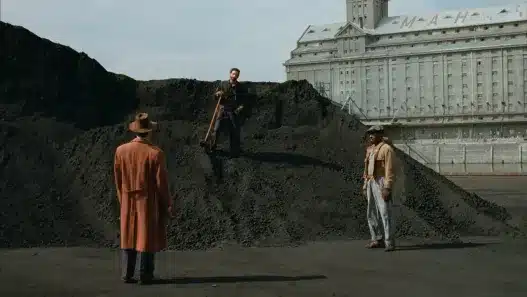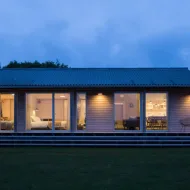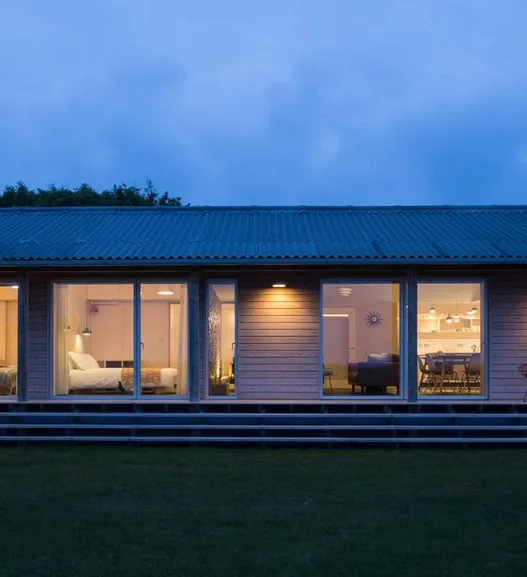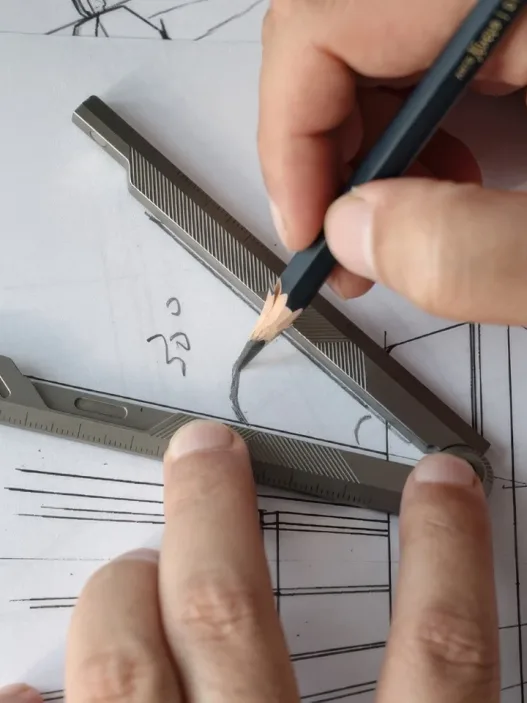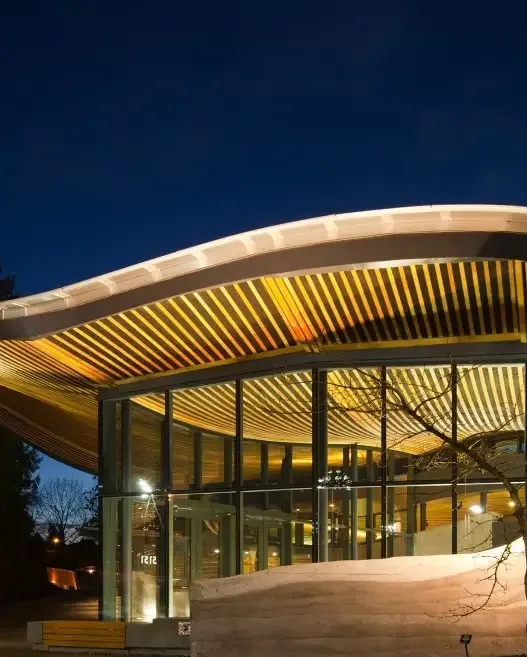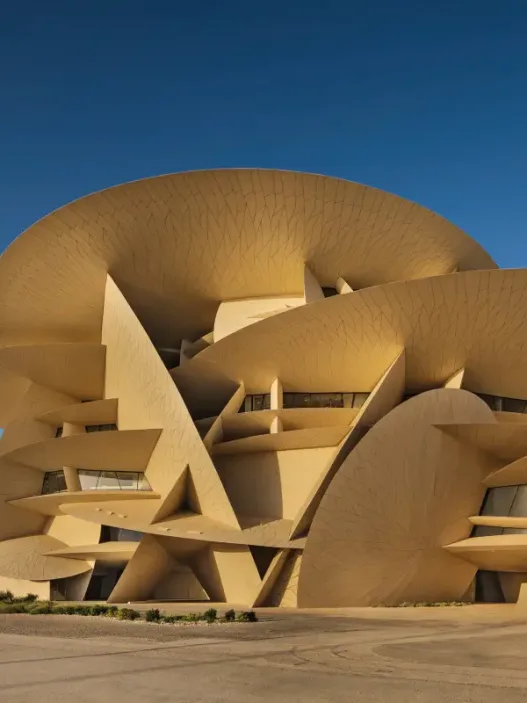The release of The Brutalist, a sprawling cinematic epic directed by Brady Corbet, ignited more than awards season buzz – it sparked a heated debate in the world of architecture. Starring Adrien Brody as László Tóth, a fictional Hungarian architect and Holocaust survivor, the film explores the raw, unapologetic aesthetic of Brutalism, weaving a story of ambition, trauma and the immigrant experience in mid-century America. Clocking in at over three and a half hours, The Brutalist has captivated film critics and audiences alike, winning accolades such as Golden Globe awards and multiple Oscar nominations as of March 1, 2025. But the movie’s depiction of architecture – and the creative liberties it took – divided the architectural community.
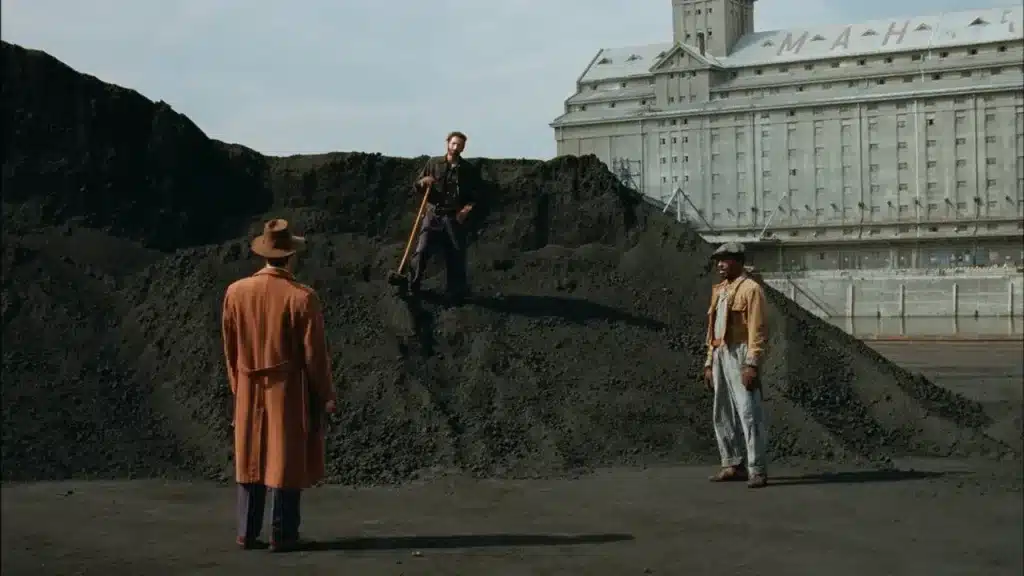
The Making of The Brutalist: Hollywood’s View of Architecture
The Brutalist is not just a movie; it is a monument to cinematic and architectural ambition. With a modest budget of $10 million, the production team crafted a visually stunning tribute to Brutalism, a post-war architectural style known for its sharp concrete forms and polarizing reputation. Shot in VistaVision, a widescreen format not used in Hollywood since the 1960s, and presented in 15-minute intervals, the film captures the grandeur and durability of the structures it portrays. However, the film’s journey from script to screen reveals a complex interplay between artistic vision and architectural originality that has provoked a backlash as great as the film itself.
Script Origins and Architectural Inspirations
The screenplay, co-written by Corbet and Mona Fastvold, is inspired by real-life Brutalist pioneers such as Hungarian-born architect Marcel Breuer, whose career parallels Tóth’s fictional journey. Trained at the Bauhaus, Breuer fled Europe during the Second World War and later designed iconic buildings such as the Breuer Building (former Whitney Museum) in New York. In The Brutalist, Tóth’s journey from a celebrated modernist in pre-war Budapest to a struggling immigrant in Pennsylvania echoes the experiences of Breuer and other immigrant architects who reshaped America’s post-war landscape.
Yet the movie is not a biography. It is a fictional tapestry woven from historical threads that blends Breuer’s influence with creative leaps. For example, Tóth’s most important project, the massive community center, complete with a cruciform void, recalls Breuer’s design for the unbuilt church for Benedictine monks in Minnesota. Critics argue that this mix sacrifices historical accuracy for drama, while others point to anachronisms, such as the film’s epilogue, set at the 1980 Venice Architecture Biennale, which feels like a reassessment of Brutalism decades too early. Yet the script’s roots in real architectural challenges give it a visceral authenticity that resonates beyond the screen.
Making an Architect a Cinematic Hero
László Tóth, played by Adrien Brody, is the heartbeat of the film, transforming the architect from a niche profession into a Hollywood hero. In a performance praised for its raw intensity, Brody plays a man torn between artistic purity and survival, a theme that echoes Brutalism’s own ethos of unadorned honesty. The casting elevates architecture to a heroic plane, in contrast to clichés like Ayn Rand’s The Fountainhead, which portrays architects as lone geniuses battling an ignorant world.
Supporting actors like Guy Pearce as the manipulative industrialist Harrison Lee Van Buren and Felicity Jones as Tóth’s sharp-eyed wife Erzsébet deepen the narrative. Their dynamic underscores the film’s exploration of power, patronage and the cost of creation, themes that mirror real-world tensions between architects and their clients. For the audience, Brody’s Tóth is not just an architect, but a symbol of resistance, making The Brutalist as compelling a character study as it is an architectural adventure.
Set Design: Recreating Brutalism on Screen
The film’s visual landscape is a triumph of production design pioneered by Judy Becker, whose credits include Carol and American Hustle. Tasked with bringing Tóth’s Brutalist vision to life on a shoestring budget, Becker captured the spirit of mid-century modernists like Breuer and Le Corbusier. Filming was primarily done cost-effectively in Hungary – rather than Pennsylvania – with active access to Brutalist relics like the József Gruber Water Reservoir in Budapest, blending real locations with fabricated sets.
The Van Buren Institute, the centerpiece of the film, exists only in the film’s universe, brought to life with a nine-meter model (later destroyed due to storage costs) and AI-generated architectural drawings. Becker’s team used tools like Midjourney to create these legendary structures, a decision that sparked controversy when it was announced by editor Dávid Jancsó. While the sets dazzle with their raw concrete texture and imposing scale, purists argue that they perpetuate the “Pinterest mentality” of Brutalism, ignoring its social and historical nuances. Regardless, the design draws viewers into Tóth’s world and makes the architecture a tangible character in its own right.
Director’s Vision: Why Brutalism Now?
There’s a reason 36-year-old former child actor Brady Corbet chose Brutalism as his canvas. At a cultural moment when the style is enjoying a resurgence – think Instagram accounts and coffee table books celebrating its understated beauty – Corbet saw an opportunity to explore its deeper resonance. “Brutalism is raw, powerful, emotional and brutally honest,” Corbet says, and these qualities are reflected in the film’s uncompromising running time and aesthetic. According to Corbet, the style’s post-war origins are linked to Tóth’s trauma and reflect a world reshaped by building from devastation.
The timing is significant. With public interest in Brutalism on the rise – Google Trends gave it a perfect 100 post-Golden Globes score – the film taps into the zeitgeist of nostalgia and reappraisal. But architects decry the film’s romanticized lens, arguing that it ignores Brutalism’s decline in the 1980s and its rejection in favor of postmodernism. Corbet’s vision, while artistically daring, positions Brutalist as a lightning rod bridging Hollywood glamor and a divisive architectural heritage.
Behind-the-Scenes Tensions over Truth
The film’s creative process was not without friction. Architects have launched a barrage of criticism, from opinion pieces in the Washington Post (“The Brutalist gets architecture wrong”) to a podcast titled Why the Brutalist Is a Terrible Movie. They denounce the depiction of the architectural process – edited for drama – and its reliance on clichés such as the tortured genius architect. The use of artificial intelligence to set the Hungarian dialog and create the buildings further inflamed tensions, with some X-users calling it “pathetic” and Oscar-eligibility.
Corbet defended his choices, emphasizing human effort over technological shortcuts. “Adrien and Felicity’s performances are entirely their own,” he told The Hollywood Reporter, explaining that the AI only corrected Hungarian vowels, not English dialog. Still, the reactions underscore a broader conflict: cinema’s need for narrative versus architecture’s demand for precision. As The Brutalist competes for an Oscar on March 2, 2025, its legacy may depend not only on its cinematic merits, but on how it reshapes – or distorts – our view of Brutalism.
Brutality Under Fire: Fact and Fiction in Film
While Brutalist dazzled audiences with its cinematic bravado, it was also harshly criticized by architects, historians and critics who argued that it sacrificed historical fidelity for dramatic flair. Far from being a love letter to Brutalism, the film became a battleground where fact and fiction collided, exposing the tensions between Hollywood storytelling and the architectural heritage it sought to honor. From misrepresented design principles to exaggerated characterizations, here’s where Brutalist has come under fire and why it matters.
Key Scenes Critics Say Are Wrong
Some moments in Brutalist have become lightning rods for criticism. Take the scene in which László Tóth unveils his design for the Van Buren Institute, a tall concrete structure with a cruciform void, during a heated confrontation with his boss Harrison Lee Van Buren. Critics argue that this melodramatic revelation oversimplifies the architectural process, reducing years of collaboration, drafting and revision to a single theatrical “eureka” moment. Real-world Brutalist projects, such as Paul Rudolph’s Yale Building for Art and Architecture, faced not instant approvals but decades of recurring challenges.
Another problematic point is the epilogue to the 1980 Venice Architecture Biennale, where Tóth’s work was celebrated as visionary. Historians note that by the 1980s Brutalism had been widely vilified, more synonymous with urban decay than praise. Architectural critic Kate Wagner, writing in the Washington Post, called it a “fantastic timeline”, arguing that the film rewrote the style’s jarring public acceptance for Hollywood’s happy ending. These scenes, as gripping as they are, fuel accusations that Brutalist prioritizes spectacle over substance.
The Real Life of Marcel Breuer vs. the Movie
The story of László Tóth is undeniably the story of Marcel Breuer, the Hungarian modernist whose Brutalist masterpieces-like the UNESCO Headquarters in Paris-defined an era. Both men were Bauhaus-trained émigrés who fled wartime Europe, reshaping American architecture with their bold visions. Yet, the parallels end there. Breuer enjoyed a relatively stable career, securing major commissions and academic posts, while Tóth’s arc in The Brutalist is a rollercoaster of poverty, betrayal, and redemption.
The film’s depiction of Tóth struggling with a single, authoritarian client (Van Buren) also departs from Breuer’s reality. Breuer collaborated with various stakeholders – governments, universities, religious orders – navigating complex bureaucracies rather than lone tyrants. Critics such as architecture professor Anthony Vidler argued that The Brutalist leaned too heavily on dramatic tropes at the expense of Breuer’s nuanced legacy, calling it a “cartoonish oversimplification”. For the Purists, Tóth feels more like a fictional concoction adapted for the screen than Breuer.
Missteps in the Depiction of Bauhaus Principles
As a Bauhaus graduate, Tóth’s architectural philosophy should reflect the school’s values of functionalism, simplicity and the integration of art and craft. However, The Brutalist portrays Tóth as a tortured dreamer obsessed with monumental scale, which some argue conflicts with Bauhaus ideals. The Van Buren Institute, with its imposing concrete mass, is more reminiscent of Le Corbusier’s later works such as Chandigarh than the lighter, modular designs of Bauhaus founders such as Walter Gropius.
Moreover, the film is Brutalism’s urban transformations in Bauhaus social optimism. Post-war Brutalists aimed to elevate communities through affordable, utilitarian spaces, an ethos lost in Tóth’s fictional struggle for personal triumph. X posts by architects like ConcreteDreams lament this misstep: “Brutalism wasn’t just about concrete, it was about people. The movie forgets that.” According to critics, this disconnect weakens the film’s claim to architectural authenticity.
The Film’s View of Brutalism’s Public Image
Brutalist portrays Brutalism as a misunderstood art form that has been rescued thanks to Tóth’s perseverance. In reality, the style’s public image has always been problematic. By the 1970s, structures like Boston City Hall were derided as cold and alienating, far removed from the film’s triumphant framing. The film’s sumptuous VistaVision shots and soaring score romanticize concrete as disconnected from its lived experience – think dank city halls or graffiti-covered campuses.
This sterilization offends critics who see Brutalism’s flaws as integral to its story. “The movie wants us to love Brutalism without taking into account why so many people hate it,” says critic Owen Hatherley, writing for Dwell. Brutalist presents a polished narrative that some call more propaganda than portrait, setting aside the decline of the style blamed on poor maintenance and urban policy mistakes.
Historians Join the Debate
Academic reactions were swift and sharp. In an essay published in the New York Review of Books, architectural historian Jean-Louis Cohen praised the film’s ambition but criticized its “historical liberties”, especially the Biennial epilogue. Meanwhile, in a panel discussion at the 2025 Society of Architectural Historians conference, participants were divided between admiration for the increased visibility Brutalist brought to the field and disappointment with its distortions.
The Bauhaus Legacy: Misrepresented or Reimagined?
At the heart of Brutalist lies the Bauhaus, a revolutionary German art school that shaped modern architecture, embodied in the person of Brutalist visionary László Tóth, a supposed graduate of the school. However, the film’s depiction of this legacy has divided opinion: Is it a bold revitalization of Bauhaus ideals, or a misrepresentation that muddies the ethos of the movement? As The Brutalist captivates audiences in 2025, it reinvigorates interest in Bauhaus principles and raises questions about how Hollywood interprets this architectural cornerstone. Here is a closer look at the ways in which the film differentiates, renews and influences perceptions of the Bauhaus legacy.
Key Bauhaus Ideas the Film Ignores
Founded in 1919 by Walter Gropius, the Bauhaus advocated functionality, simplicity and the fusion of art, craft and technology to create affordable, human-centered designs. But in The Brutalist, László Tóth’s obsession with monumental concrete forms like the Van Buren Institute contradicts these principles. By portraying Tóth as a lone genius rather than a collaborator, the film emphasizes grandeur over utility, in stark contrast to the communal workshops of the Bauhaus, where architects, artists and artisans worked together.
Critics also emphasize the social and cultural impact of the Bauhaus. Post-World War I, the school sought to rebuild society through accessible design-a goal Brutalism later echoed in projects like London’s Barbican Estate. Yet, Tóth’s journey in The Brutalist is intensely personal, sidelining the movement’s utopian drive. “It’s Bauhaus without the heart,” tweeted @BauhausReborn, reflecting a sentiment that the film cherry-picks aesthetics over ideology.
How Brutalist Reinvents Modernism
Despite these shortcomings, Brutalist does not discard the Bauhaus, but reinterprets it through a cinematic lens. Tóth’s Brutalist creations are sumptuous yet retain a modernist streak: Clean lines, raw materials and an unapologetic rejection of ornamentation, hallmarks of Bauhaus influence. Director Brady Corbet relates Tóth’s austere designs to his Holocaust survival, framing this reinvention as a response to trauma; a narrative that reconstructs modernism as an emotional outlet rather than a rational system.
This approach resonates with some viewers. The film’s use of VistaVision reinforces the scale and texture of the structures, evoking a visceral connection to concrete that feels modernist in spirit, if not in doctrine. Supporters argue that rather than a betrayal of Bauhaus, it is a bold evolution that adapts its principles to the post-war American context, where individualism trumps collectivism. For better or worse, it reimagines Brutalist modernism as a personal crusade, not a public good.
Bauhaus Graduates Who Shaped Style
Tóth’s fiction is informed by real Bauhaus luminaries who bridged the school’s ideals with Brutalism. Marcel Breuer, a student and later instructor, pioneered the expressive potential of concrete in works such as St. John’s Abbey Church, which blends Bauhaus restraint with Brutalist gravity. Another Bauhaus figure, László Moholy-Nagy, brought experimental materialism to America, influencing both industrial design and architecture. Even Walter Gropius himself, though less Brutalist, laid the groundwork with his focus on modular, functional forms.
In Brutalist, Tóth stands as a composite of these pioneers, but his isolation sets him apart. Unlike Breuer, who thrived on partnerships, or Moholy-Nagy, who embraced interdisciplinary innovation, Tóth’s lone wolf persona is more Hollywood than historical. Nevertheless, by basing its vision on Bauhaus education, the film pays tribute to these graduates and offers a fictionalized lens on how their ideas may have been shaped under different pressures.
The Impact of the Film on the Perception of the Bauhaus
The Brutalist is undeniably reshaping the public’s view of the Bauhaus as it racks up accolades that have swept the Golden Globes and set its sights on the Oscars in March 2025. According to recent trends, Google searches for “Bauhaus architecture” increased by 40% after its release, suggesting that the film has brought the movement into mainstream consciousness. Its romanticized approach, linking Bauhaus to personal triumph, contradicts its academic image as a cerebral, utilitarian experiment and potentially broadens its appeal.
But this comes at a price. Casual viewers may now associate the Bauhaus with Brutalism’s divisive concrete monoliths rather than its lighter, more versatile roots, such as Gropius’ Fagus Factory. “Thanks to The Brutalist, everyone now thinks Bauhaus is just sad concrete,” @DesignNerds joked on X. The film’s impact, then, is twofold: it revitalizes interest, but risks turning the movement’s legacy into a cinematic caricature.
Defending the True Spirit of the Movement
Amid the backlash, Bauhaus defenders are pushing back. Organizations like the Bauhaus Archive in Berlin have organized screenings and panels to clarify the movement’s mission, highlighting its role in affordable housing and elements of democratic design that Brutalist largely ignores. Scholars like Dr. Magdalena Droste argue that the film captures the visual DNA of the Bauhaus but misses its spirit: “It’s not just about form; it’s about improving lives.”
Conservation and Perception: The Cultural Challenge of Brutalism
Beyond the silver screen, The Brutalist thrust Brutalism into the spotlight of the real world, fueling an ongoing battle over its preservation and public image. Once derided as the poster child for urban blight, this concrete-clad style is currently enjoying a resurgence. Fueled by nostalgia, activism and now the Hollywood gaze. As of March 1, 2025, the film’s cultural ripple effect is undeniable, but it also underscores a deeper tension: Can Brutalism’s legacy endure as its physical icons crumble and its reputation remains divisive? Here’s how preservationists, the public and popular culture are shaping the fight for the future of Brutalism.
Iconic Brutalist Buildings at Risk Today
Brutalism’s physical legacy is under siege. Structures such as Chicago’s Prentice Women’s Hospital, demolished in 2014 despite protests, highlight the style’s fragility. Today, landmarks such as the Geisel Library at UC San Diego – William Pereira’s 1970 concrete masterpiece – face maintenance issues, and the cost of repairs has led to debates over demolition and restoration. In the UK, Alison and Peter Smithson’s 1972 residential complex Robin Hood Gardens was partially razed in 2017, despite heritage groups fighting to save it.
These losses reflect wider threats: aging materials, changing urban priorities and a lack of legal protection. The World Monuments Fund’s 2025 watch list includes several Brutalist structures that signal a global crisis, such as the Centro Cultural São Paulo in Brazil. Brutalist‘s soaring Van Buren Institute may be fictional, but its cinematic presence has brought new attention to these real-world relics and prompted calls to preserve what remains before it’s too late.
Public Opinion: Loved or Hated?
Brutalism has never been neutral; it’s a style that people either love or hate. According to a 2024 YouGov poll, 38% of Americans consider Brutalist buildings to be “ugly”, citing their harshness and association with failed urban projects like Pruitt-Igoe. Yet, in the same survey, a countercurrent of 18% praised the boldness of these buildings, led by younger generations. At X, users like @BrutalLover say “Concrete is poetry”, while @CitySkeptic retorts “A stain on our skyscrapers”.
This division is not new. By the 1980s, the image of Brutalism had collapsed, associated with crime-ridden estates and bureaucratic gloom. Today, however, social media and Brutalist perceptions are changing. Post-Golden Globes, the hashtag #BrutalismResurgence trended and fans shared photos of favorite structures like Boston City Hall. The film’s romantic lens may not erase decades of disdain, but it convinces skeptics to reconsider the allure of concrete.
Efforts to Save Concrete Landmarks
Conservationists are mobilizing to protect endangered icons of Brutalism. Groups like Docomomo International are advocating for the buildings to be listed as heritage sites, providing legal safeguards against demolition. In London, the campaign to preserve the Brutalist complex of the Southbank Centre (Hayward Gallery, Queen Elizabeth Hall) won a victory by gaining Grade II* status in 2024. Across the Atlantic, the #SavePreston campaign is fighting to protect Preston Bus Station, built in 1969 and under threat of redevelopment.
These efforts face uphill battles: concrete decay (spalling, cracking) requires costly repairs and public apathy often prevents funding. Still, Brutalist garnered support. After its release, crowdfunding surged for projects like restoring Paul Rudolph’s Orange County Government Center, with donors citing the film as inspiration. For activists, this is a rare opportunity to translate cinematic excitement into concrete action.
How Movies Shape Architectural Heritage
Cinema has long influenced how we see architecture – think the dystopian sprawl of Blade Runner or the modernist dogma of The Fountainhead. Brutalist joins this pantheon, portraying Brutalism as a misunderstood art form redeemed by László Tóth’s journey. With a 92% on Rotten Tomatoes as of March 2025, the film’s sumptuous visuals and emotional weight offer a counter-narrative to the style’s notoriety, potentially reshaping its legacy for a new generation.
Critics warn of oversimplification. “The movie may dazzle, but it can’t fix leaky roofs,” says Architectural Review. Yet its impact is tangible: Museum exhibitions such as MoMA’s “Concrete Dreams” (opening April 2025) report a renewed interest in Brutalism, while architecture schools are reporting an increase in Brutalism-focused theses. By framing the style in heroic terms, the film bridges the past and present and influences how we value and fight for its remnants.
Brutalism’s Unexpected Pop Culture Moment
Brutalist is not the only star turn of Brutalism. From Kanye West’s 2018 Yeezy Home concepts echoing Tadao Ando’s concrete minimalism to TikTok’s #BrutalistAesthetic, where Generation Z pays tribute to grainy textures, the style’s blocky allure has infiltrated popular culture. Fashion is following suit: Balenciaga’s Fall 2024 collection featured Brutalist-inspired silhouettes, sharp angles and shades of gray. Even video games like Control (2019) revel in fictional Brutalist labyrinths.
The movie reinforces this wave. Post-Oscars, Etsy reports a 25% increase in Brutalist decor – like concrete planters and geometric prints – while Spotify playlists titled “Brutalist Vibes” blend industrial beats with moody ambience. This pop culture moment, sparked by The Brutalist, shows that the appeal of Brutalism goes beyond architecture and has become a symbol of raw, unfiltered expression in a polished digital age.
Oscar Buzz and the Architectural Ripple Effect
As The Brutalist enters the 97th Academy Awards on March 2, 2025 with 10 nominations, including Best Picture, Best Director and Best Actor, the Oscar buzz reverberates far beyond Hollywood. Hailed as a cinematic triumph, the film’s focus on Brutalism is stirring a complex mix of excitement, skepticism and hope in architectural circles. Could this awards season juggernaut reshape how we see and preserve this polarizing style? Here’s how The Brutalist‘s Oscar race is making waves that could reverberate for decades to come.
Why The Brutalist is an Award Contender
The Brutalist has all the makings of an Oscar favorite: an expansive running time of 3.5 hours, a visionary director in Brady Corbet and an impressive performance by Adrien Brody as László Tóth. The film swept the Golden Globes for Best Motion Picture (Drama), Best Director and Best Actor, and its critical acclaim (92% on Rotten Tomatoes) and success at Venice and in critical circles cemented its pioneering status. Shot on VistaVision and projected in 70mm, the technical ambition of the film won awards for cinematography and production design for the monumental architecture it portrays.
The emotional weight of the film, which chronicles Tóth’s journey from Holocaust survivor to architectural pioneer, resonates with Academy voters who favor stories of resilience and art. Its timely exploration of power dynamics and migrant struggles adds depth, making it stand out among 2025 contenders like Conclave and Emilia Pérez.
Architects’ Mixed Reactions to Hype
While movie critics are drooling, architects are divided. Some hail Brutalist for bringing their field into the mainstream – “The field is getting that attention,” architecture professor Victoria Young told AFP. Others are troubled by the movie’s inaccuracies. A podcast trio – Alexandra Lange, Mark Lamster and Carolina A. Miranda – titled their review “Why Brutalist is a Terrible Movie”, criticizing the clichéd lone genius trope and Brutalism’s poor grasp of the timeline. The Washington Post’s Philip Kennicott echoed this criticism, calling the film’s depiction of architecture “painfully dated.”
The AI controversy-stemming from editor Dávid Jancsó’s reveal of its use for Hungarian dialogue and renderings-further fueled ire. X user @ArchCritic fumed, “A movie about craft using AI? Hypocrisy.” Yet, defenders like @BrutalFanatic argue, “It’s art, not a documentary-chill.” This split reflects a broader tension: gratitude for visibility versus frustration at misrepresentation.
Can Nominations Increase Preservation Funds?
The Brutalist‘s Oscar nomination could be a lifeline for crumbling icons of Brutalism. With landmarks like the Preston Bus Station and Geisel Library threatened with demolition, preservationists see a glimmer of hope. Following the film’s release, crowdfunding for Paul Rudolph’s Orange County Government Center increased by 15%, with donors citing the film as motivation. Docomomo International reports increased interest in listing efforts such as the Southbank Center’s recent Grade II* listing.
An Oscar win could reinforce this further. Historical examples, such as Schindler’s List increasing Holocaust memorial funds, show that awards can boost cultural investment. “If it wins Best Picture, expect a flood of grants,” predicts heritage advocate @SaveBrutalism on X. While concrete repair costs can be daunting, the movie’s visibility can impact public and private wallets and turn celluloid buzz into real-world bricks.
Hollywood’s History of Design-Driven Film
Brutalist joins the ranks of Hollywood films where design is not only a backdrop but also a character. The Fountainhead (1949) fetishized modernist ideals through Gary Cooper’s Howard Roark, while Blade Runner (1982) created a dystopian aesthetic that still inspires architects. More recently, Parasite (2019) used its sleek home to underscore class divisions and won Best Picture. Each has utilized architecture to strengthen the narrative, just as The Brutalist‘s concrete monoliths reflect the spirit of Tóth.
Yet these films often favor drama over accuracy – The Fountainhead‘s skyscrapers were pure fantasy, just as The Brutalist‘s Van Buren Institute blended styles. Hollywood’s track record shows that design-driven stories resonate with Oscar voters, but architects are often intimidated by poetic license. The Brutalist fits this mold, combining visual ambition with the lure of reward.
Long-term Cultural Fallout
Win or lose, Brutalist is set to leave a lasting mark. Its cultural impact is already evident: MoMA’s “Concrete Dreams” exhibit (April 2025) has noted the film’s traction, while Brutalism’s Google Trends score reached 100 post-Golden Globes. At X, #BrutalismResurgence is trending, with debates over its legacy – “Will kids romanticize concrete towers now?” asks @CultureVibe.
Critics fear a shallow legacy-Kyle Chayka warned in Bluesky that “bad AI renderings” could dilute the depth of Brutalism. Yet its punk-inspired resurgence in fashion and music points to a wider embrace. In the long run, The Brutalist could redefine Brutalism as a symbol not just of post-war gloom, but of courage and reinvention – provided the Oscar glitz doesn’t become a cliché.










